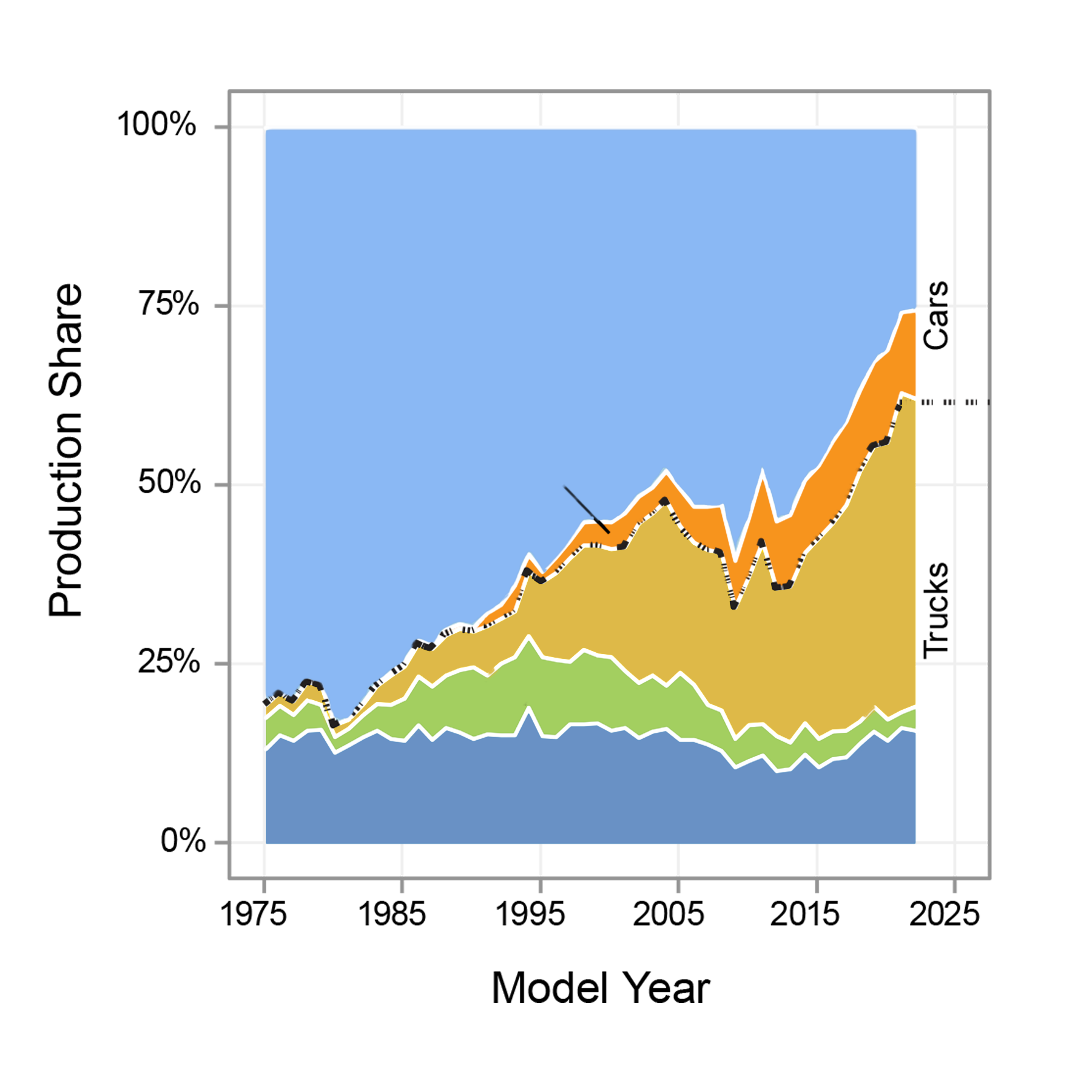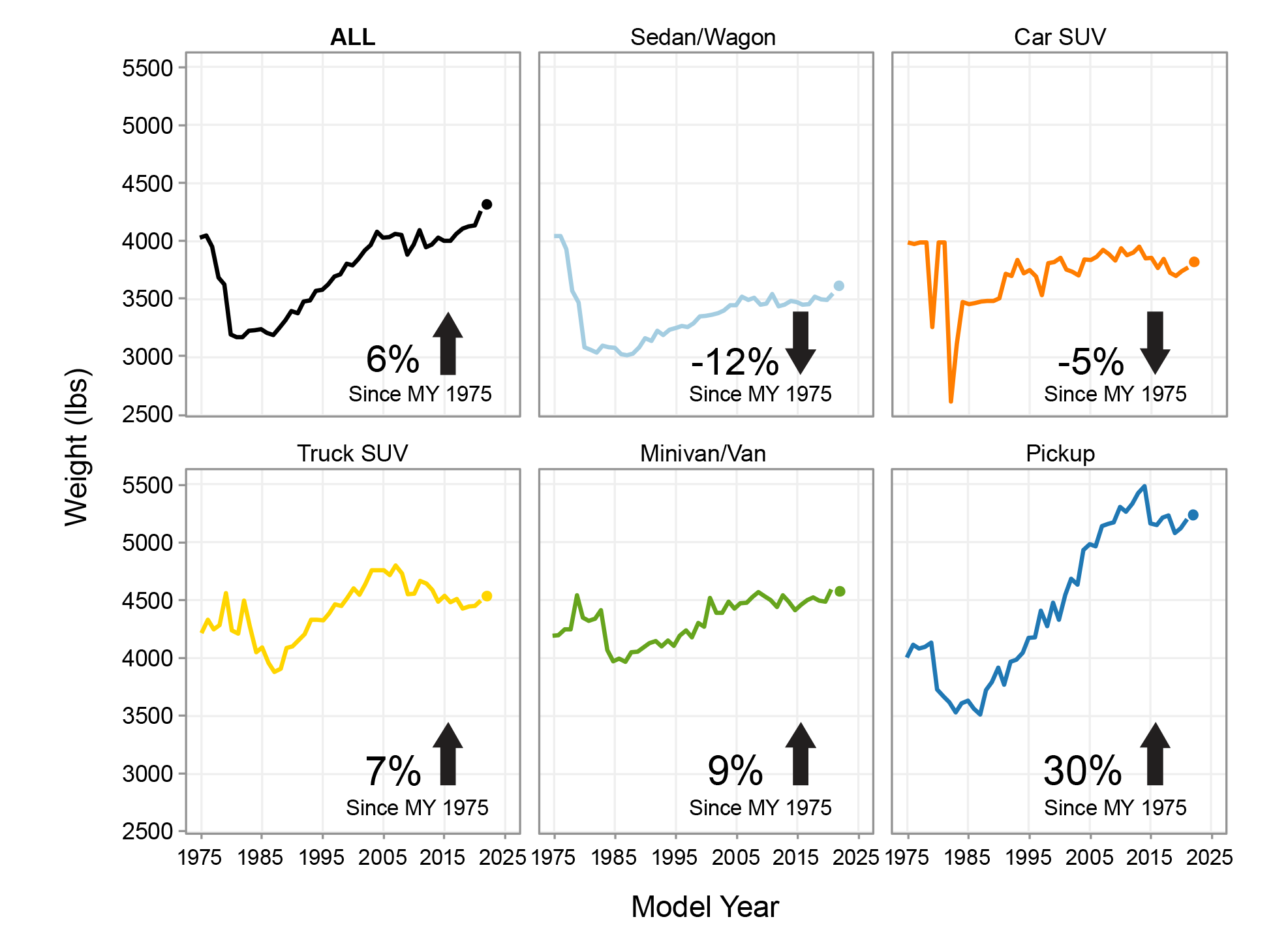The Impact of Vehicle Electrification on Safety
Aligning the Pushes for EVs and Safer Roads
Our “How Vehicle Electrification Affects the Gas Tax” post from last year got us thinking of other changes that could flow from increasing numbers of EVs on streets…
The Federal government has set a target calling for 50% of new cars to be electric by 2030, and 100% by 2035, and many states have similar goals. The EPA announced new tailpipe emission standards in April of this year with the aim to encourage car manufacturers to shift their production even sooner. California has gone further and banned the sale of gasoline-powered cars by 2035. We’ve seen it asserted that this push for more EVs, while well-intentioned, could be at odds with the safety goals in the National Roadway Safety Strategy and Vision Zero commitment due to heavier vehicle weights.
We set out to determine whether the vehicle weight trends support the assertion that climate-driven EV policies clash with roadway safety goals, and further, how vehicle design and policy in the evolving EV market could alter the recently increasing rate of death and severe injuries on American roads.
Relationship Between Vehicle Characteristics and Safety
Why is electrification relevant to safety? Electric vehicles replace gas-powered engines with significantly heavier batteries. You may have seen that the Ford F-150 Lightning, the EV version of America’s most popular selling vehicle, weighs 6,000+ pounds, approximately 50% heavier than the gas-powered version of the same vehicle.
The size and weight of a vehicle are key factors in the likelihood that a serious or fatal injury occurs from a collision, whether to the people inside or those outside of it. Vehicles with a high profile, large footprint, and heavy weight transfer more energy upon impact compared to smaller passenger cars. Pedestrians, bicyclists, and people in smaller vehicles have a higher average likelihood of being severely harmed or killed if struck by a bigger, heavier vehicles.
weight matters.
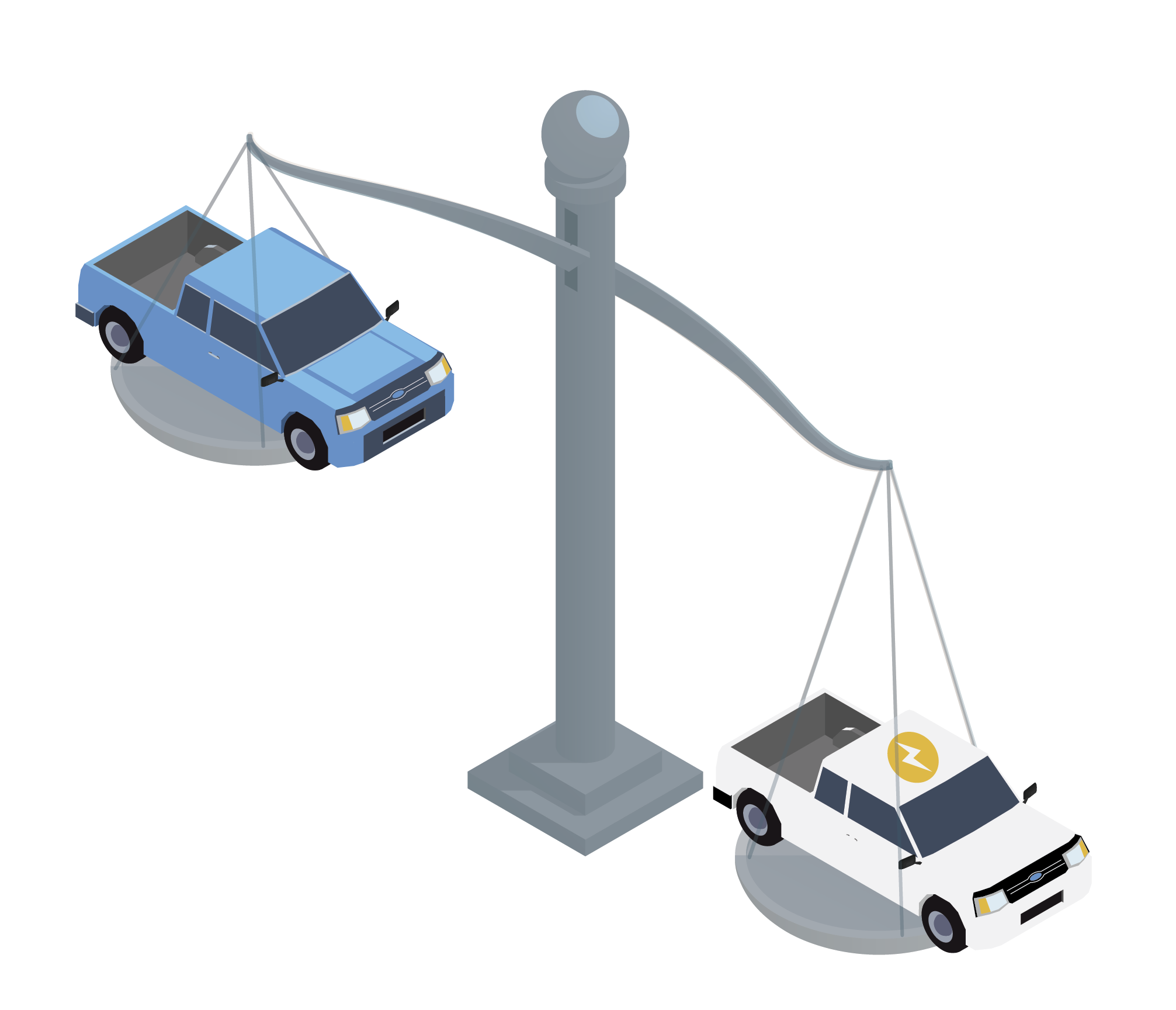
Energy Matters.
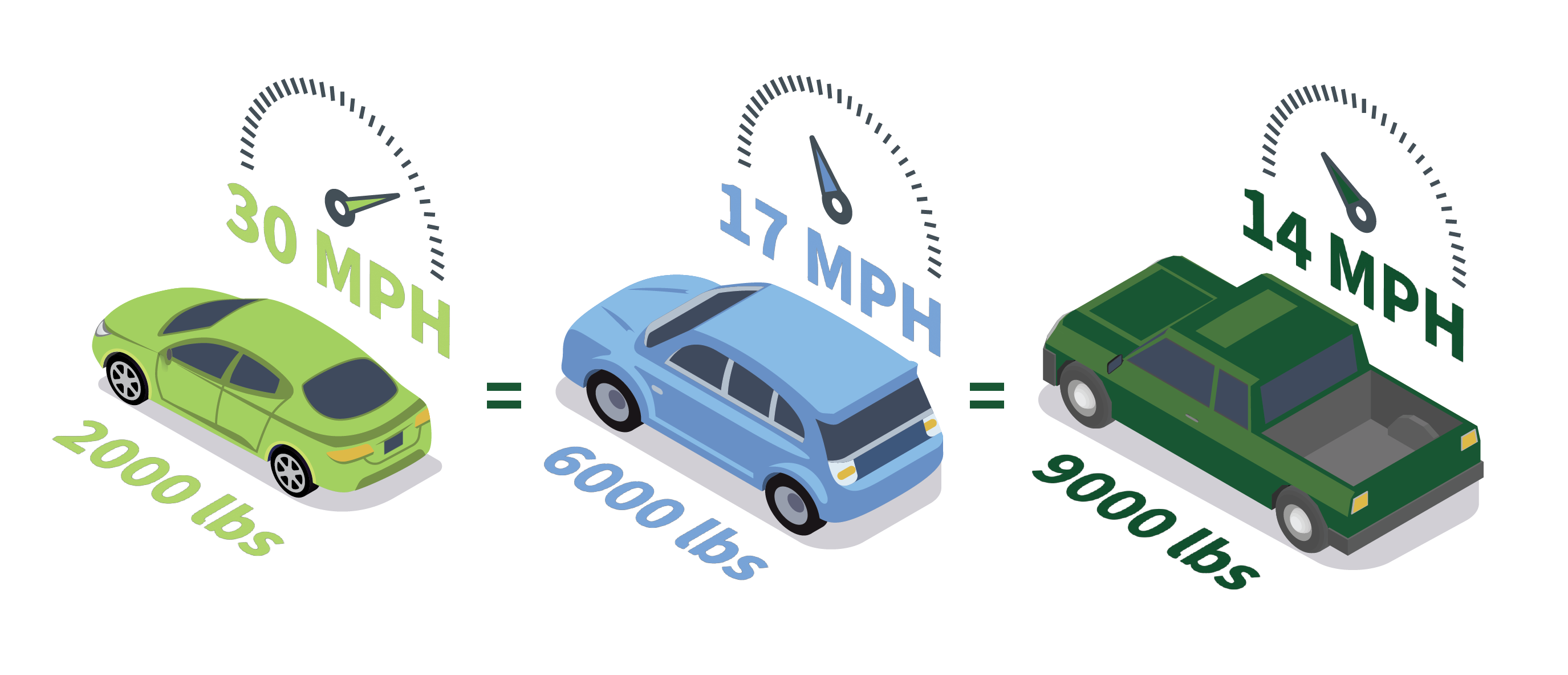
Size Matters.
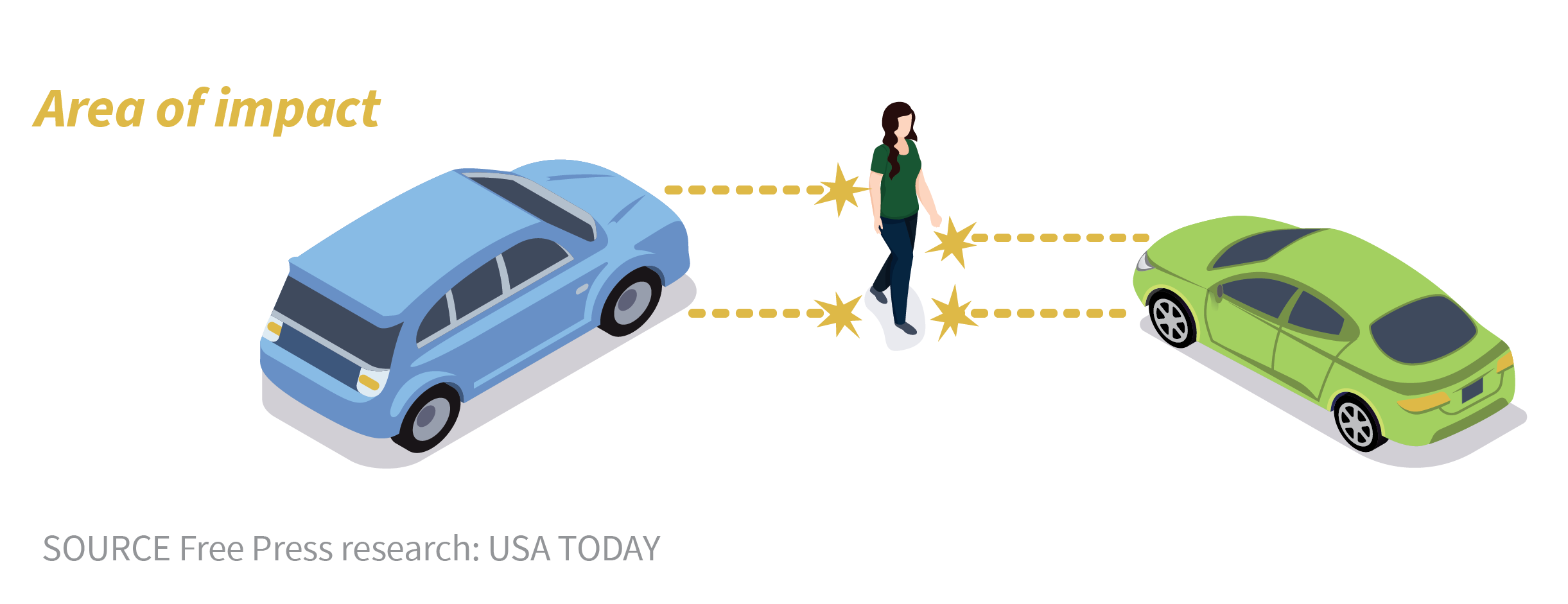
Electric Vehicles – Impact on Weight Distribution and Implementation Scenarios
There is a lot of uncertainty around what the new fleet of EVs could look like as their adoption spreads. Using data to put the projected increase in vehicle weights into perspective, we looked at two scenarios for the adoption of EVs compared to the current vehicle weight distribution. First, we analyzed a scenario in which the forecasted share[1] of EVs would be made up of the most popular EV models today, like the Tesla 3 or the Chevy Bolt. Secondly, we analyzed a scenario in which the EV market might shift to vehicles more like our current vehicle distribution (i.e., more trucks and SUVs, fewer sedans and passenger cars). Here’s what we found.
Both scenarios show that EVs contribute to a heavier fleet, but they follow a trend of increasing weights that have been well-established for decades. While electric vehicles are poised to contribute to the increasing weight of vehicles, their adoption could be designed to slow this trend. The size and weight of U.S. vehicles has steadily climbed over the last three decades, much prior to electrification. The share of gas-powered trucks, SUVs, and minivans has leapt from less than 25% of the market in 1985 to nearly 75% in 2022. Further, all vehicle types have been getting heavier, causing the average overall weight of the new vehicle fleet to climb by 34% since 1985. While electric vehicles are poised to contribute to the increasing weight of vehicles, their adoption could be designed to slow this trend.
The future of road safety is heavily dependent on the size and shape of vehicles. If EVs dominate the future market, their design and the policies that shape them are going to play a key role in safety outcomes.
The U.S. Loves Big Cars – The Policy Choices and Market Forces That Led Us Here.
The American preference for large vehicles stems from the Corporate Average Fuel Economy (CAFE) standards introduced in the 1970s. To meet these standards, car manufacturers were incentivized to improve fuel efficiency mostly by shedding weight. However, an exception in the policy for light-duty trucks (originally intended to negate adverse impacts on jobs that required a large vehicle) created a loophole. As CAFE Standards exist today, pickup trucks, SUVs, and minivans can be classified as “light-duty trucks” allowing for more lax fuel efficiency requirements. This has had the effect of encourages car manufacturers to produce larger, heavier vehicles to meet their fuel efficiently targets.
Consumer preference for larger vehicles has been partially driven by a desire for passenger safety, as larger and heavier vehicles are less likely to result in injuries or fatalities for the people inside of them. Between sparse regulations for vehicle size, and a built environment that supports parking and driving big cars, there’s not much limiting how big our cars can get. Additionally, advancements in fuel efficiency have removed the prohibitive costs associated with fueling a large and heavy car, making them more appealing for everyday travel needs.
This trend of increasing vehicle size may continue with the rise of electric vehicles. Marketing for EVs tends to highlight size, power, and acceleration capabilities, which indicates that the shift away from gas-powered vehicles doesn’t mean a clean break from the tropes that have given us bigger and ever more powerful cars.
For over half a century, Federal policies have intentionally or not, supported vehicle fleet characteristics that decrease road safety for those outside the vehicle. Electric vehicles do not pose a new or unique threat to Vision Zero: they are simply the climate-friendly reimagination of a persisting contradiction between vehicle design and safety goals.
What Can Policy Do to Align EV Adoption and Safety Goals?
We have the unique opportunity to reinvent the wheel when it comes to influencing electric vehicle size and weight to better align with local, state, and national safety goals. Here are five ways that the transportation community (i.e., federal/state/local agencies, car manufacturers, the logistics industry, etc.) could pair the shift to greener vehicles with a focus on enhanced safety:
Adopt and advance Vision Zero policies
that lead to safer and saner streets. Both safer vehicles and safer streets are critical elements of effective implementation.
Tax credit eligibility
Tax credits could be explicitly tied to weight and size to encourage the purchase of comparatively lighter vehicles.
Tax EVs by weight
Imposing a tax directly on car manufacturers could affect a reduction in EV sizes/weights from the production side.
Introduce vehicle size/design standards that consider safety for those outside of the vehicle
- Integrate pedestrian protection and crashworthiness as a measure of safety for each new vehicle design (including vehicle weight)
- Include pedestrian and bicycle collision avoidance technology
- Limit speed and acceleration for new vehicles above a certain weight
Limit the potential for conflicts between vulnerable road users and heavy vehicles
- Implement speed reduction engineering measures and enforcement through red light cameras.
- Advocate for speed safety cameras to reduce instances of high-speed collisions. With more weight on the streets, it’s important to lower speeds in certain areas.
- Plan for and implement curbside management to reduce cruising for parking and loading zones and consolidate freight zones to areas with fewer vulnerable user conflict points.
- Develop a layered network and create truck routes to reduce bicycle and pedestrian conflicts.
Despite current trends and US consumers preferences for larger vehicles, we stand at a unique time to influence road safety through vehicle design and policy, inclusive of electric vehicles If you’re interested in learning more about aligning the growth of EVs with safety goals in your jurisdiction, please contact us!
____
[1] Forecasted share of the new vehicle fleet is estimated to be 30% by 2030 (https://evadoption.com/ev-sales/ev-sales-forecasts/) with nearly 5 million annual sales. Current market share is about 3.5%.
Contributors

Nina Price
Engineer/Planner

Eric Womeldorff
Principal



